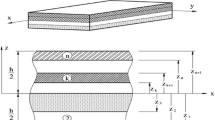Abstract
There are analytical methods for predicting the buckling loads of columns with the boundaries ideally fixed, i.e., simply supported or built-in, or partially fixed. Vibration-test results may furnish a practical method of measuring the fixity. In this investigation a beam, that may or may not be loaded as a column, is assumed to have a torsional spring at each end such that a zero torsional stiffness corresponds to a simply supported end and an infinite torsional stiffness corresponds to a built-in end. From a Rayleigh-Ritz analysis, the buckling load and the fundamental frequency of the beam are each computed as a function of the torsional stiffness. This procedure leads to a one-to-one nondimensional relationship between the buckling load and the natural frequency. From these calculations, it is seen that regardless of the degree of clamping of one end relative to the other end, all that is needed to predict the buckling load within a 15-percent range is a knowledge of the theoretical buckling load of the simply supported column; the theoretical fundamental frequency of the simply supported beam; and the experimental fundamental frequency. Experimental results are presented to support the theory.
Similar content being viewed by others
Abbreviations
- EI :
-
flexural rigidity, lb in.2
- i,m,n :
-
number of half waves in harmonic vibration
- k 1,k 2 :
-
torsional stiffnesses, lb in./rad
- L :
-
length of beam or column, in.
- m 0 :
-
mass per unit length, lb sec2/in.2
- P :
-
column load, lb
- q i :
-
generalized coordinate, in
- \(\dot q_i \) :
-
generalized velocity, in./sec
- T :
-
kinetic energy, lb in.
- t :
-
time, sec
- U 1,U 2 :
-
potential energy, lb in
- w :
-
lateral deflection, in
- x :
-
coordinate of position, in
- α:
-
\(\frac{{2k_1 L}}{{\pi ^2 EI'}}\), nondimensional stiffness
- β:
-
\(\frac{{2k_2 L}}{{\pi ^2 EI'}}\), nondimensional stiffness
- λ:
-
\(\frac{{PL^2 }}{{EL\pi ^2 }}\), nondimensional buckling load
- ω:
-
fundamental frequency, rad/sec
- Ω:
-
\(\frac{{\omega L^2 }}{{\pi ^2 }}\left( {\frac{{m_o }}{{EI}}} \right)^{{\raise0.7ex\hbox{$1$} \!\mathord{\left/ {\vphantom {1 2}}\right.\kern-\nulldelimiterspace}\!\lower0.7ex\hbox{$2$}}} \) nondimensional frequency
Author information
Authors and Affiliations
Rights and permissions
About this article
Cite this article
Jacobson, M.J., Wenner, M.L. Predicting buckling loads from vibration data. Experimental Mechanics 8, 35N–38N (1968). https://doi.org/10.1007/BF02327414
Issue Date:
DOI: https://doi.org/10.1007/BF02327414




